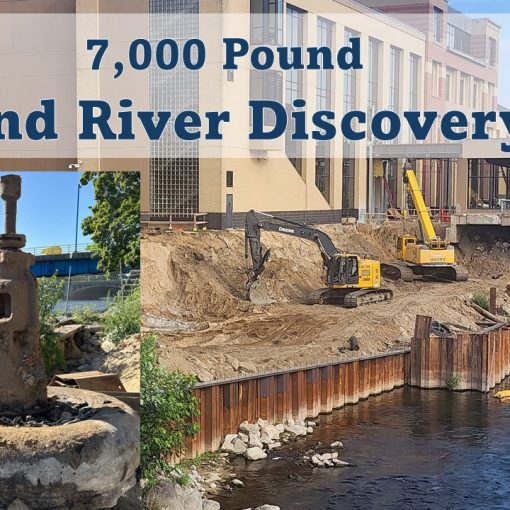Throughout North America in the crisp, early spring people gather around steamy pans of boiling maple sap. Neighbors come together around evaporators to swap stories and share memories as part of the syrup making ritual. Join Chuck and I as we visit two west Michigan families who keep this time-honored tradition alive.
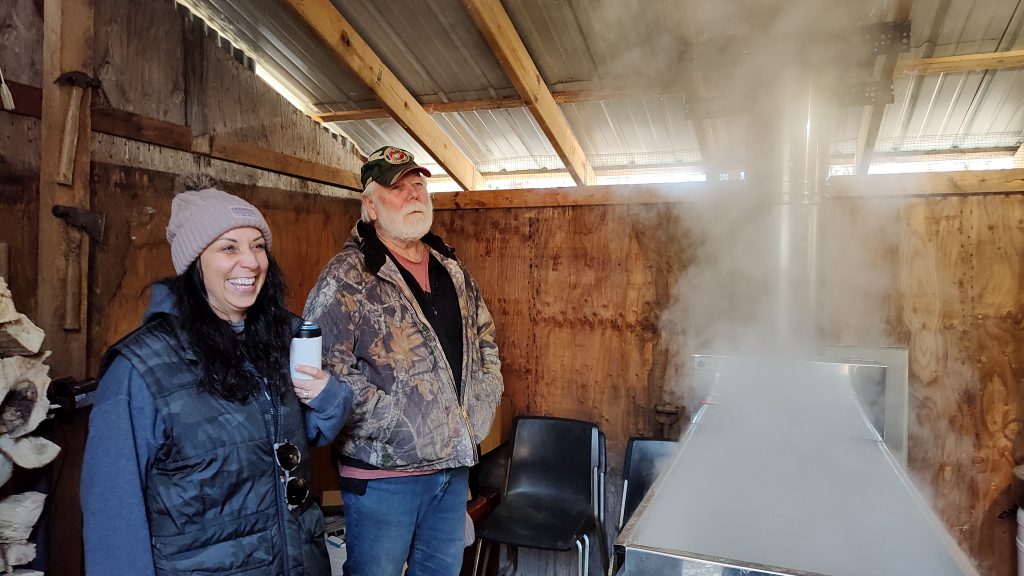
The Theule Family – Maple Hills Sugar Bush
On the south side of Grand River Avenue one thousand maple trees were dressed in ten miles of plastic garland tubing, collecting sap. David Theule’s grandparents had immigrated from the Netherlands in 1919 and purchased one hundred acres of land for a dairy farm.
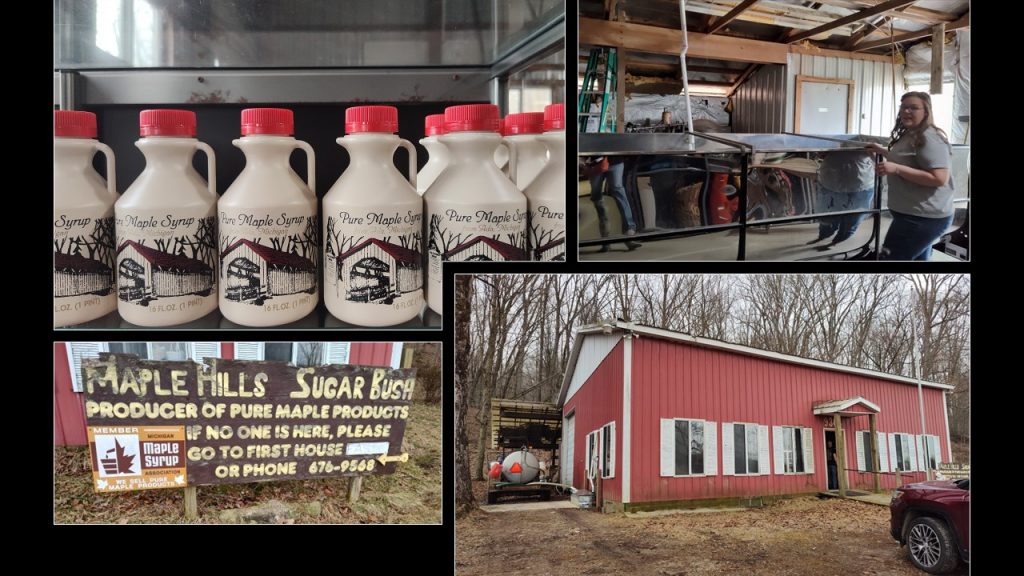
Dave’s grandson, Levi, and girlfriend, Kennedy, were working alongside their patriarch the day we arrived. Kennedy showed us around inside. Levi offered, “I can introduce you to grandpa if you want. He just pulled up with his tractor.” We followed him outside.
Dave greeted us warmly as he hopped off the tractor. “How’d you get started?” Chuck asked. Suddenly, silence enveloped us, as if the trees leaned in to listen. Dave paused from his work and answered. “Well, years ago in a one room, country school house, we took a tour of a sugar house back in the woods. I was so impressed that I said, ‘Someday I want to be doing this.'”
Just over a decade later in 1970, newly weds, Dave and Connie Theule began tapping their maple trees and processing maple syrup. That was 55 years ago and they’re still making syrup today!
Collecting Sap
As we chatted, Dave was in constant motion hooking up the sap tank on the tractor to the holding tub inside. “It takes about 45 gallons of sap to make one gallon of syrup.” Dave, Connie and their family collect around 10,000 gallons of sap each season which produces about 200 gallons of syrup.
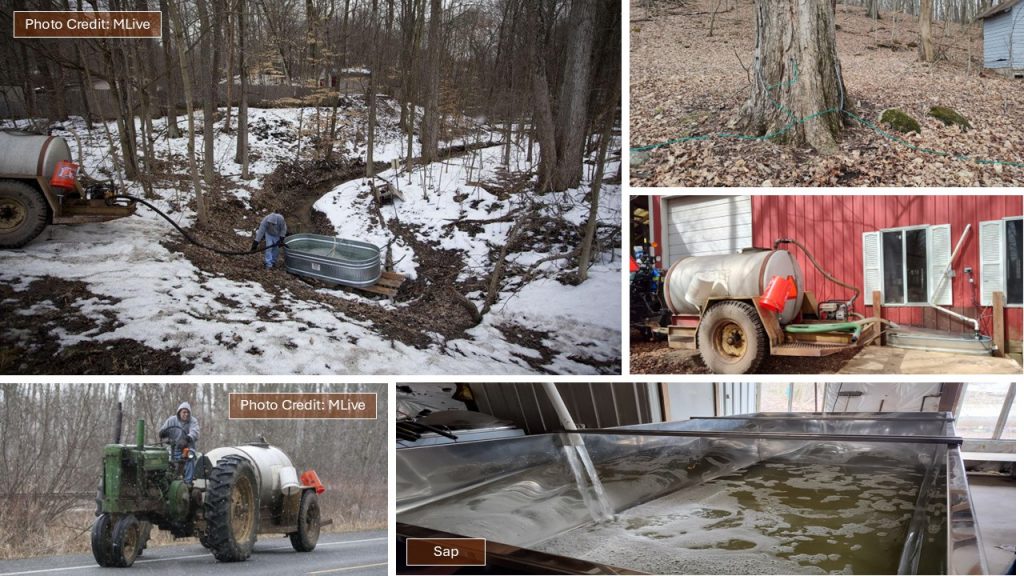
The sap is kept cold in an enormous, indoor tub while it awaits the boiling process.
Ideally, the temperature needs to dip below freezing at night and then rise to above thirty-two degrees during the day in order for maple sap to flow. “Sap is like milk.” Dave said to Sandra Cheng, an MLive reporter, “If it’s not kept in a cold place, it will go bad.”
Collecting sap early in the morning when it’s still cold is best. “It makes it better. The syrup doesn’t get spoiled as quickly.” Dave added, “In warmer weather, trees want to gain strength to make leaves, but colder weather prevents that. If you have leaves and warmth, bugs come,” he said.
Evaporation
The next step is to boil off the water which will leave golden syrup. To do this, a wood-fire, “Small Brothers,” evaporator is used. The elongated pan has a crimped bottom to aid in speedier evaporation. Then the remaining liquid goes into a gas-fueled “finisher,” which filters the sap once again.
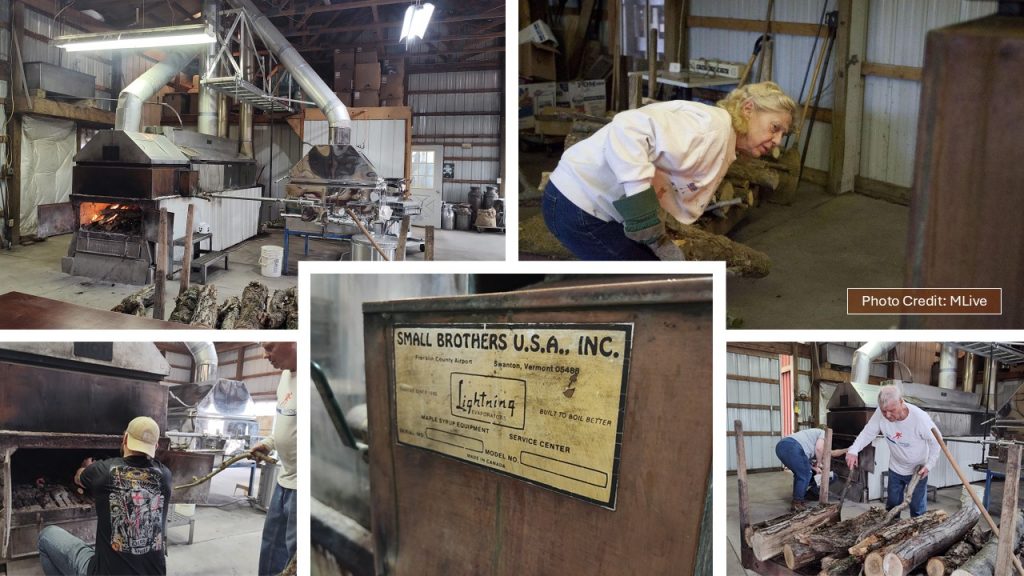
Connie, Levi, Kennedy and Dave haul their logs from the shed to the wood-burning evaporator.
As I peeked into the machine Kennedy explained, “When it’s going, you have to check the level every ten minutes.” One hundred-forty gallons of water is removed each hour.
Refractometer Measurement
A refractometer measures the sugar content of the liquid. The “liquid gold” needs to reach at least 66% sugar content to be authentic maple syrup. Dave always aims for 67%.
Bottling
Dave had explained bottling to MLive reporter, Sandra Cheng. “The faster you bottle, the better, because the syrup has to be kept hot. If the syrup has a temperature higher than 180 degrees Fahrenheit, it produces cloudiness. If it’s less than 175, the bacteria is not completely killed. So you try to hit 180 every time.”
We thanked the Theules for their generosity and time teaching us about their beloved business. With our purchases in hand, we headed to an intimate family operation, The Baker’s sugar shack, Huckleberry Hollow.
The Baker Family, Huckleberry Hollow
While researching maple syrup I spied a familiar face on a “Maple Syrup” Facebook page. It was Liz Baker! Anyone from Lowell knows Liz! She had recently retired from being our Chamber of Commerce leader, where she organized Lowell activities, building a strong community year-round. We’d even done committee work together. So I sent her a message. She responded right away and invited us out for their sugar shack party! I was honored.
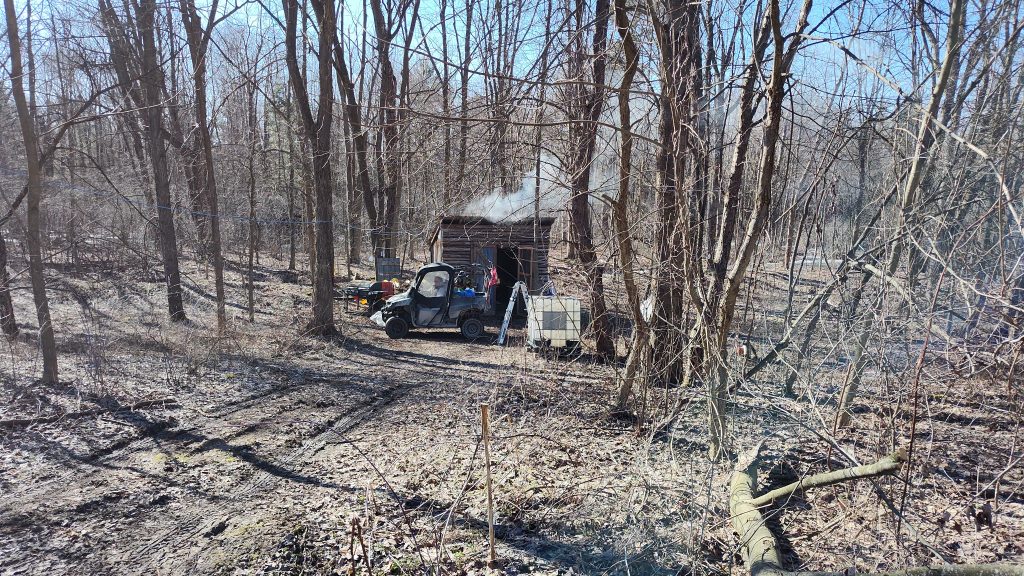
A wall of steam greeted us as we entered the sugar shack. “This is sweet!” Chuck stated as we entered. Did he intend the pun, I wondered? Mike Baker responded right away. “We built this all out of scrap stuff.” He nodded. The first years the family had boiled their sap outside over an open fire. Now this shed and newer evaporator provides a cozy nook in the woods, known to the family as “Huckleberry Hollow.”
The Baker family has been having sugar parties for ten years now. “I guess we just wanted to try it.” Liz shrugged when asked why they began this project.
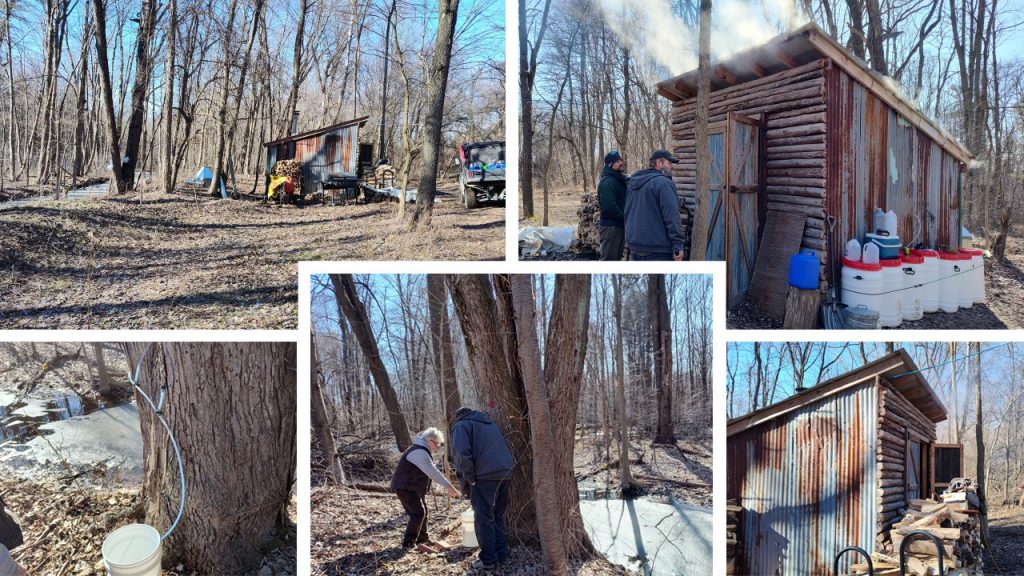
The grandkids all take part in the processes: cutting wood, collecting sap, stoking the fire, finishing the last filtered boil in the kitchen and bottling the liquid gold. Each year Grandma Liz has specially made sweatshirts for her clan. “They have to earn them by doing a job.” She smiled.
When asked about their operation, Mike explained, “We have 103 taps right now. Some of them (trees) even have four taps in them. So we have about 50-55 trees.” A maple tree needs to be at least ten inches in diameter to have one tap. A larger tree can handle more taps, placed at least six inches apart.
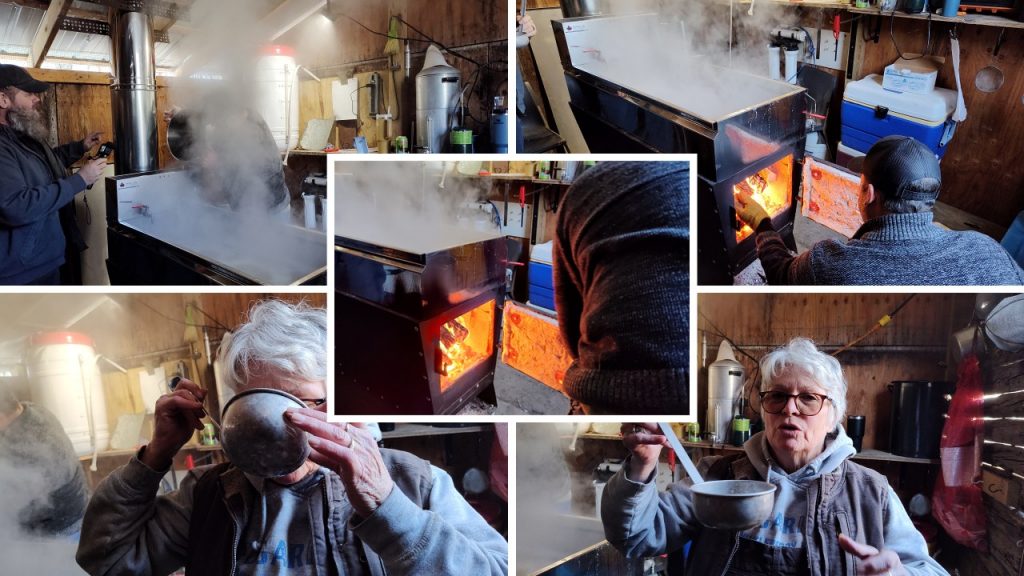
Liz swirled a ladle in the boiling sap. Once it cooled we all took a sip. The warm, sweet liquid coated my throat with a medicinal feeling.
Maple Syrup Health Benefits
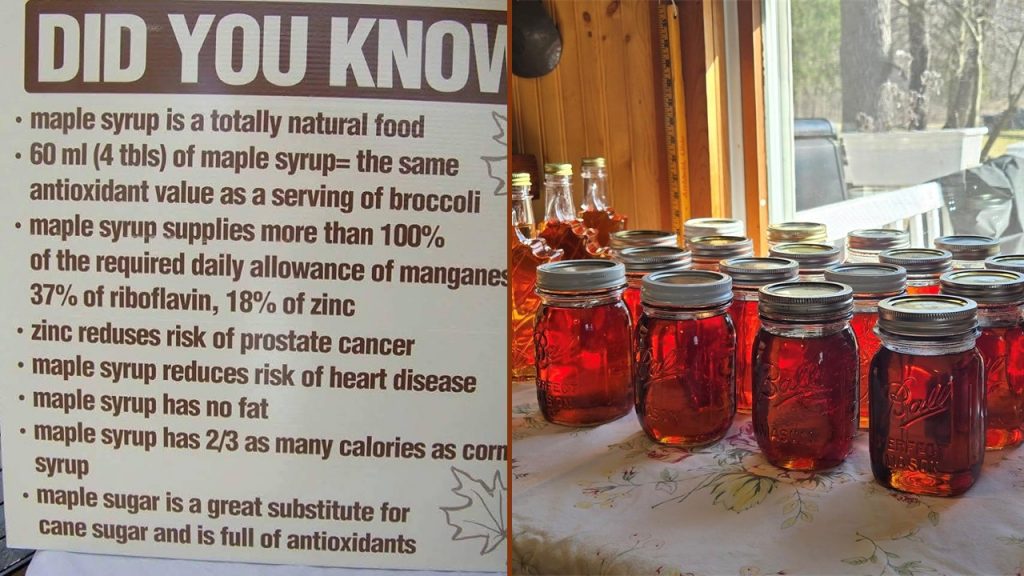
Maple syrup holds essential minerals: calcium, zinc, magnesium and potassium. There’s inflammation reducing polyphenols, also found in fruit, red wine and green tea. Polyphenols support a healthy immune system. Maple syrup aids in digestion, too, with its prebiotic fiber and inulin.
Maple Syrup – More Than Meets The Eye
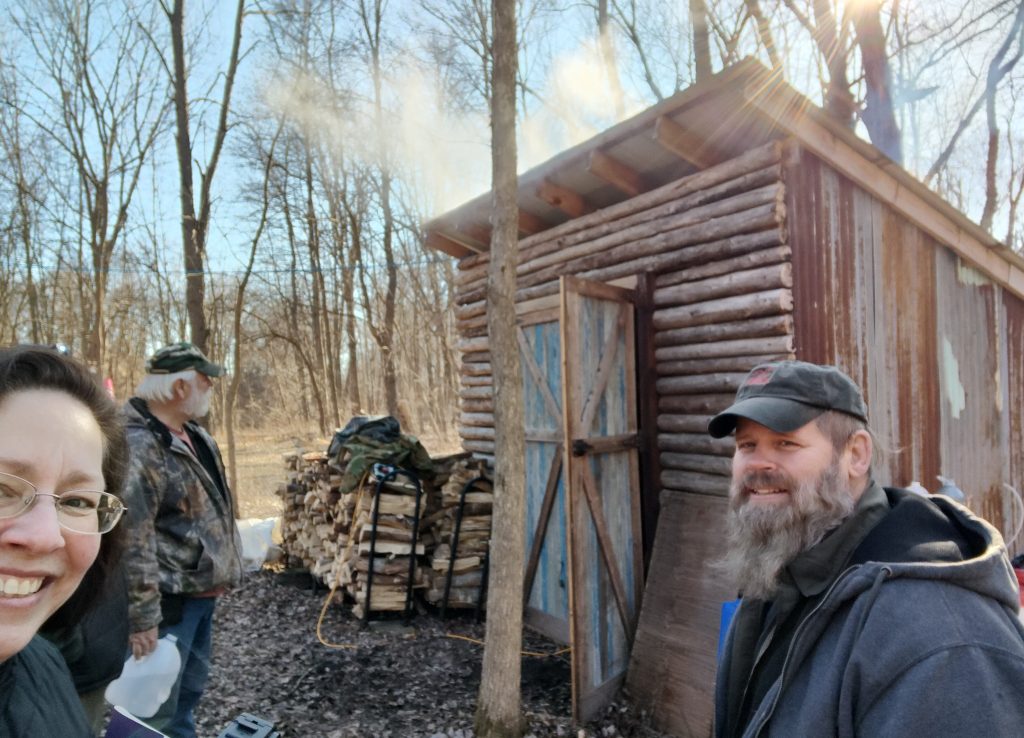
Not only does maple syrup provide natural health benefits but Canada provides over 70% of the world’s supply of maple syrup. This “liquid gold” brings a $615 million dollar return to Canada as it’s exported to sixty countries. (Take their flag, for instance. It even has the maple leaf on it!)
More importantly, though, this centuries-old harvest of maple sap brings people together, stoking the fire and sharing stories. Working as a team to accomplish a goal builds community, satisfaction and a heap of smiles to look back on over a lifetime. Special thanks to the Theule family and the Baker clan! Stay curious and make memories!
Related Links:
“The Food That Changed The World” Restless Viking article about the history of maple sap.
Enjoy our Restless Viking YouTube video about maple sap!
Resources:
Dave, Levi and Kennedy at Maple Hills Sugar Bush
Liz and Mike Baker
“Maple Syrup Season: For an Ada Couple It Is The Sweet Sign of Spring” MLive article
by Sandra Cheng March 2013
“Discover Five Amazing Facts About Canadian Maple Syrup” article
by Athena McKenzie February 17, 2025
“The Story of Maple” article and video
Coombs Family Farm website
Maple Trader website
Atlas Obscura Gastro Obscura article
“The Story of Maple” video
Maple Syrup Made How article
Maple Syrup Production Facts article
The History of Maple Syrup article
The History of Maple Products video
Sticky Gold article by Brendan Borrell January 9, 2013





